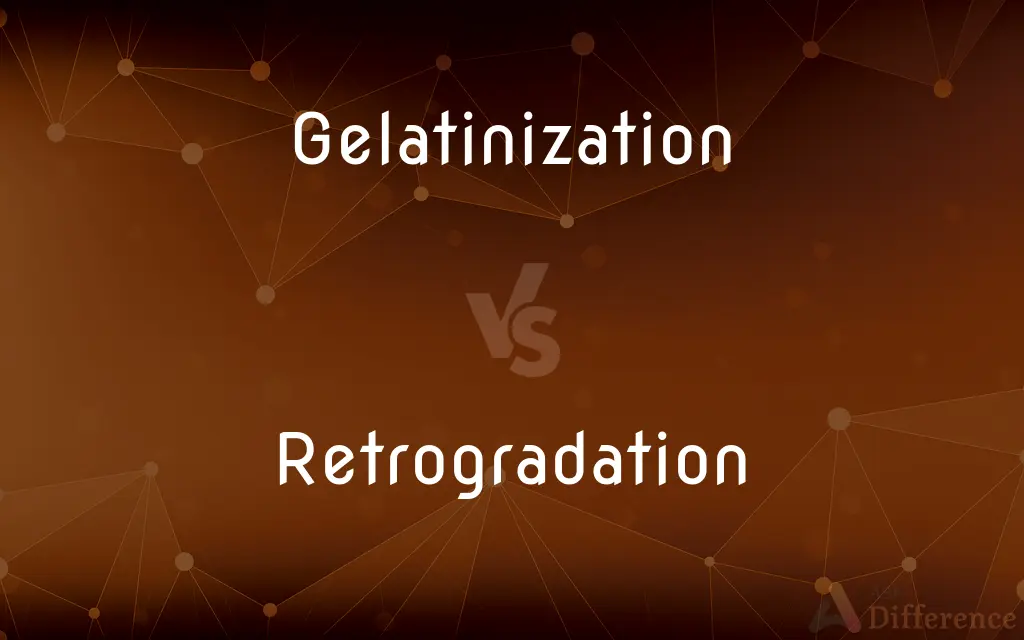Gelatinization vs. Retrogradation — What's the Difference?
Edited by Tayyaba Rehman — By Urooj Arif — Updated on March 21, 2024
Gelatinization involves starch granules absorbing water and swelling at high temperatures, while retrogradation is the recrystallization of starch molecules as cooled gelatinized starch sets.

Difference Between Gelatinization and Retrogradation
Table of Contents
ADVERTISEMENT
Key Differences
Gelatinization is a process where starch granules absorb water and swell upon heating, leading to the thickening of mixtures. This occurs in a specific temperature range and is crucial for the texture of foods like sauces and puddings. Whereas retrogradation refers to the phenomenon that happens after gelatinization when the gelatinized starch begins to cool and set. This process can lead to the formation of a gel and is responsible for the staling of bread and other baked goods.
During gelatinization, the molecular structure of starch changes as the granules absorb water, causing them to swell and eventually burst. This leads to the release of the starch molecules into the surrounding liquid, thickening it. On the other hand, during retrogradation, the amylose and amylopectin chains in starch realign themselves as they cool, forming a structured network that traps water molecules, which can result in a firmer texture.
Gelatinization requires heat and is often induced by cooking, such as boiling or baking, which activates the starch's ability to absorb water and expand. It is a critical step in cooking and baking to achieve the desired consistency in foods. Retrogradation, however, occurs after gelatinization when the temperature of the starch is lowered, such as during cooling or refrigeration, and can affect the texture and quality of food over time.
The temperature at which gelatinization occurs varies depending on the type of starch, with each type having a specific temperature range for optimal gelatinization. In contrast, retrogradation is a time-dependent process that can occur at a range of temperatures below the gelatinization point, and its rate can be influenced by factors such as the type of starch and storage conditions.
Understanding the differences between gelatinization and retrogradation is important in food science and culinary arts, as manipulating these processes can impact the texture, shelf life, and overall quality of food products. While gelatinization is used to achieve the desired thickness and consistency in foods, managing retrogradation is key to extending the freshness and palatability of starch-rich foods.
ADVERTISEMENT
Comparison Chart
Definition
The process of starch granules absorbing water and swelling at high temperatures.
The recrystallization of starch molecules as cooled gelatinized starch sets.
Temperature
Occurs at high temperatures.
Occurs at lower temperatures, after cooling.
Process
Starch granules absorb water, swell, and burst, thickening the mixture.
Starch molecules realign and recrystallize, potentially firming the texture.
Impact on Food
Results in thickening and is essential for the texture of various dishes.
Can lead to the staling of bread and changes in texture of cooled foods.
Importance in Cooking/Baking
Critical for achieving desired consistency in foods.
Important for understanding texture changes and shelf life of food products.
Compare with Definitions
Gelatinization
Determines the quality and consistency of starch-based foods.
The gelatinization of starch is crucial for the smooth consistency of custards.
Retrogradation
Involves the reassociation of starch molecules, particularly amylose and amylopectin.
During retrogradation, amylose and amylopectin chains in starch realign, causing texture changes.
Gelatinization
The process where starch granules absorb water and swell upon heating.
Gelatinization occurs when making a roux for thickening sauces.
Retrogradation
The process where gelatinized starch cools and recrystallizes, affecting texture.
Retrogradation is responsible for the firming of pudding upon refrigeration.
Gelatinization
Involves the disruption of intermolecular bonds of starch molecules in the presence of water and heat.
During gelatinization, the molecular structure of starch changes, allowing it to thicken gravy.
Retrogradation
Leads to the staling of bread and other starch-rich foods.
Bread undergoes retrogradation, which results in a staler texture over time.
Gelatinization
A critical process in the cooking and baking industry for achieving desired textures.
Proper gelatinization is essential for the light and fluffy texture of cakes.
Retrogradation
Affects the shelf life and quality of cooked and baked goods.
Retrogradation is a key factor in the shelf life of bakery products.
Gelatinization
Temperature-dependent and varies among different types of starch.
The gelatinization temperature of cornstarch is lower than that of potato starch.
Retrogradation
Can be influenced by storage conditions and starch type.
The rate of retrogradation in rice can affect the texture of leftover rice dishes.
Gelatinization
To convert to gelatin or jelly.
Retrogradation
Retrogradation is the landward change in position of the front of a river delta with time. This occurs when the mass balance of sediment into the delta is such that the volume of incoming sediment is less than the volume of the delta that is lost through subsidence, sea-level rise, and/or erosion.
Gelatinization
To coat with gelatin.
Retrogradation
Moving or tending backward
A retrograde flow.
Gelatinization
To become gelatinous.
Retrogradation
Opposite to the usual order; inverted or reversed
The retrograde form of the melody.
Gelatinization
The act of making or becoming gelatinous.
Retrogradation
Reverting to an earlier or inferior condition
A retrograde way of thinking.
Gelatinization
Same as Gelatination.
Retrogradation
Of or relating to the orbital revolution or axial rotation of a planetary or other celestial body that moves clockwise from east to west, in the direction opposite to most celestial bodies.
Retrogradation
Of or relating to the brief, regularly occurring, apparently backward movement of a planetary body in its orbit as viewed against the fixed stars, caused by the differing orbital velocities of Earth and the body observed.
Retrogradation
Of or relating to orbital motion in the direction opposite that of the predominant motion in an orbital system.
Retrogradation
(Astronomy) To have retrograde motion.
Retrogradation
To decline to an inferior state; degenerate.
Retrogradation
(Archaic) To move or seem to move backward.
Retrogradation
Motion in a retrograde manner.
Retrogradation
Decline, degradation.
Retrogradation
(chemistry) A reaction that takes place in gelatinized starch when the amylose and amylopectin chains realign themselves, largely responsible for bread becoming stale.
The major reason that bread stales is not moisture loss, but rather a process called retrogradation, in which the starch molecules in the bread crystallize.
Retrogradation
The act of retrograding, or moving backward.
Retrogradation
The state of being retrograde; decline.
Common Curiosities
What is gelatinization?
Gelatinization is the process where starch granules absorb water and swell upon heating, leading to the thickening of mixtures.
How does gelatinization affect food texture?
Gelatinization affects food texture by thickening and stabilizing mixtures, essential for the consistency of sauces, puddings, and baked goods.
How can retrogradation affect the texture of refrigerated foods?
Retrogradation can make refrigerated foods firmer and drier over time, as the starch molecules realign and form a tighter structure.
Is gelatinization reversible?
Gelatinization itself is not reversible; once starch granules have absorbed water and swollen, they cannot return to their original state.
Can freezing affect retrogradation?
Freezing can slow down the retrogradation process but may not stop it completely, as the low temperatures can slow down molecular movement.
Can retrogradation be reversed?
Retrogradation can be partially reversed by reheating, which can temporarily disrupt the recrystallized starch structure.
Does the type of starch affect gelatinization temperature?
Yes, the type of starch significantly affects its gelatinization temperature, with different starches requiring different temperatures to gelatinize.
What causes retrogradation in foods?
Retrogradation is caused by the cooling and subsequent recrystallization of gelatinized starch, leading to changes in food texture.
Why is understanding gelatinization important in cooking?
Understanding gelatinization is crucial for achieving the desired texture and consistency in various dishes, especially those that are starch-based.
What factors influence the rate of retrogradation?
Factors such as the type of starch, temperature, and the presence of other ingredients can influence the rate of retrogradation.
What role does retrogradation play in the staling of bread?
Retrogradation contributes to the staling of bread by causing the starch to recrystallize and harden, affecting its texture and moisture content.
How do cooking methods influence gelatinization?
Different cooking methods, such as boiling, baking, or steaming, can influence the extent and rate of starch gelatinization.
Share Your Discovery

Previous Comparison
Reflect vs. Think
Next Comparison
Direct vs. FocusedAuthor Spotlight
Written by
Urooj ArifUrooj is a skilled content writer at Ask Difference, known for her exceptional ability to simplify complex topics into engaging and informative content. With a passion for research and a flair for clear, concise writing, she consistently delivers articles that resonate with our diverse audience.
Edited by
Tayyaba RehmanTayyaba Rehman is a distinguished writer, currently serving as a primary contributor to askdifference.com. As a researcher in semantics and etymology, Tayyaba's passion for the complexity of languages and their distinctions has found a perfect home on the platform. Tayyaba delves into the intricacies of language, distinguishing between commonly confused words and phrases, thereby providing clarity for readers worldwide.














































